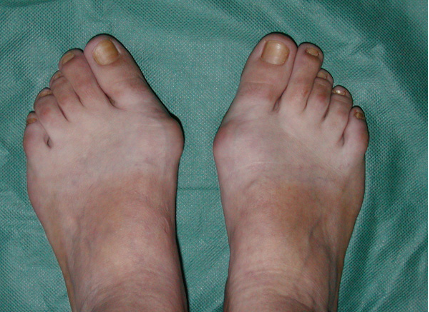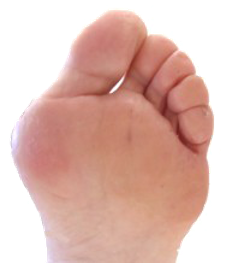What is hallux valgus?
What is the cause or risk factors of hallux valgus?
Is hallux valgus a common disease in Hong Kong?
Apart from changes in external appearance, will hallux valgus affect daily activity?
Can the disease be reversed by proper shoe wear?
When should one seek treatment for hallux valgus?
What is the treatment of hallux valgus?
Non-operative treatment
What is the advantage of open surgery? Will it cause wound related complications?
How about minimal invasive surgery (MIS)?
Can daily activity modification help those at risk?
How to avoid children from developing develop hallux valgus if their parents are sufferers?
How to relieve symptoms if one cannot avoid high heel shoes at work?
What is hallux valgus?
Our toes normally point forward. In hallux valgus, the big toe points to the lateral side. This allows the base of big toe to enlarge. The direction of muscle pull is changed, resulting in deviation of big toe. At the early stage, hallux valgus leads to altered appearance of the foot. As the disease progresses, the patient suffers from bunion pain, deformed toes and callosity. In the worst case, the patient cannot wear normal shoes or clean the toe webs. Wound develops. It will be a disaster if patient also suffers from diabetes, as infection can be difficult to control.


What is the cause or risk factors of hallux valgus?
It can be congenital or acquired. In acquired cases, bony mal-alignment, abnormal soft tissue tension, over exercise, underlying disease or abnormal pressure are risk factors. Examples include rheumatoid arthritis, gout, ballet, wearing high heel and pointed shoes. In addition, hallux valgus is related to flat foot.
Is hallux valgus a common disease in Hong Kong?
According to a literature review in 2010 , the prevalence of hallux valgus in adults is 23%, and 26% in females. It is more prevalent in elderly.
Apart from changes in external appearance, will hallux valgus affect daily activity?
In the early phase of disease, change in apperance is the only presentation. As disease progress and with development of bunion, patients complain of bunion pain, callosities, skin abrasion, pain on exercise, hiking, or even walking on level ground and standing. They have problem in wearing shoes.
Can the disease be reversed by proper shoe wear?
Wearing proper shoes and adopting a better life style can relieve mild symptoms. They are not sufficient to control severe symptoms.
When should one seek treatment for hallux valgus?
Treatment should be sought when symptoms like pain, difficulty in shoe wearing, and problems with daily activies such as walking and hiking develop.
What is the treatment of hallux valgus?
Treatment can either be non-operative or operative. Non-operative treatment can relieve pain and prevent further deterioration. However, in patients with severe hallux valgus with deformity, operative treatment is needed to correct the deformity. Some patients are not fit for corrective surgery, eg severe rheumatid arthritis, or degeneration of toe joint. They can benefit from joint fusion.
Non-operative treatment
— Can physiotherapy help and correct hallux valgus?
Physiotherapy helps by stretching and strengthening foot muscles and decreasing the load to big toe. Orthotics and podiatry provide orthosis like toe spreader, splint or insole to prevent deterioration of hallux valgus.
— Effect of non-steroidal anti-inflammatory drugs (NSAID)
Non-steroidal anti-inflammatory drugs can reduce inflammation at toes. However, inflammation will recur if the primary cause of hallux valgus is not addressed. There are side effects of NSIAD as well. They are prescription drugs.
What is the advantage of open surgery? Will it cause wound related complications?
If non-operative treatment fails, the next step will be surgery. There are more than hundreds of operations for hallux valgus and each has its own indication.
The aim of surgery is to release the lateral tight structure and tighten up the medial loose structure, with or without bony cut, to correct the angle and fix back with screw.
This can be done through a number of open wounds with seperation of periosteum. There are risk of complications arising from these open wounds.
How about minimal invasive surgery (MIS)?
Soft tissue surgery and bone osteotomy can be performed in MIS technique. For example, by using endoscope, small incision can be made through skin, and the lateral tight structure can be cut using a small endoscopic knife, then medial loose structures can be tightened by percutaneous suture. Small drills can be used for bone cutting. These method can reduce the size of wound and separation of periosteum. A more speedy recovery is expected.
There are however contra-indications for MIS at this moment, including severe deformity, stiffness, or multiple toes involvement.
Can daily activity modification help those at risk?
A pair of shoes with a wide toe box to adapt all toes is needed. The shoe lace should be tightened to avoid slipping of shoe from the foot. Avoid high heel or narrow toe box shoes. Regular stretching and exercises to foot muscles can strengthen the foot arch. This is helpful.
How to avoid children from developing develop hallux valgus if their parents are sufferers?
Same as the above. Find a pair of good shoes. Do more stretching and strengthening exercise. If symptoms develop, seek medical advise promptly.
How to relieve symptoms if one cannot avoid high heel shoes at work?
It is a difficult but common situation. To minimise the the adverse effects, choose shoes with lower heel and a wider toe box. Shorteren the duration of wearing them, for example, change to another pair of shoes while working in back stage. We need to get balance between health and life.
Dr. Angela Ho